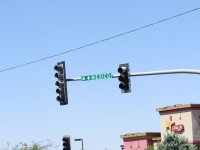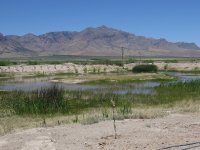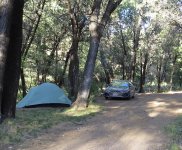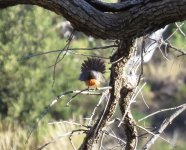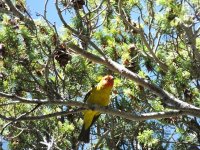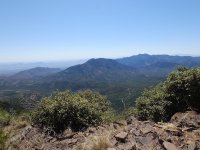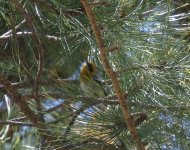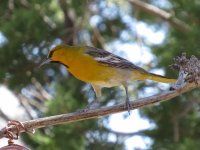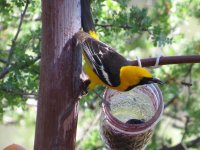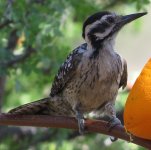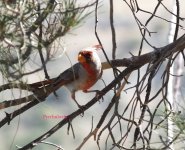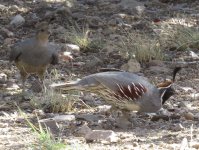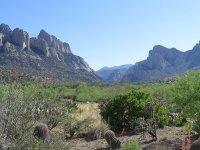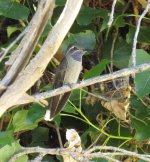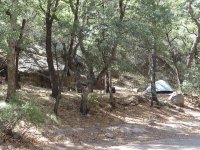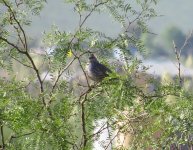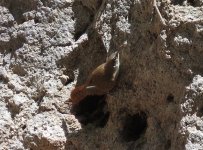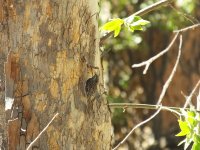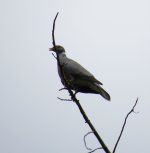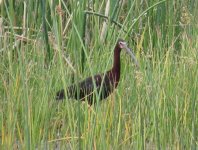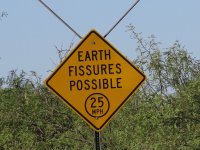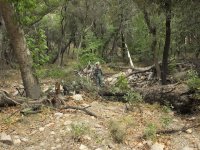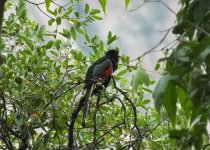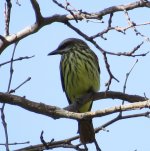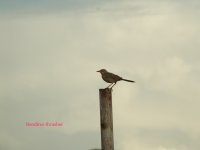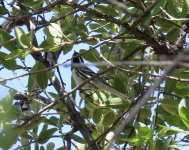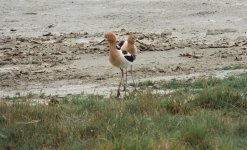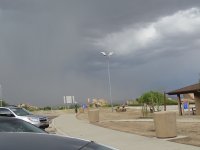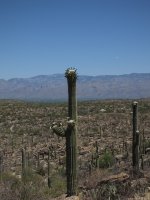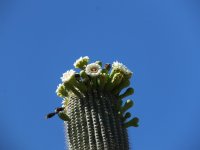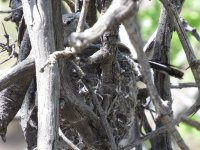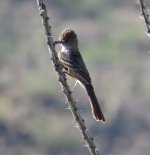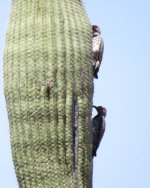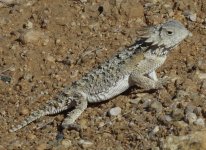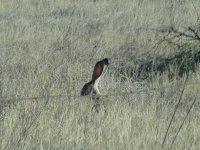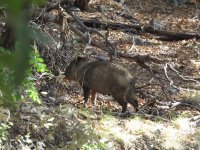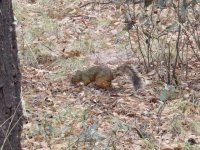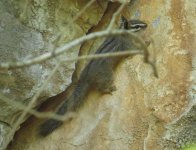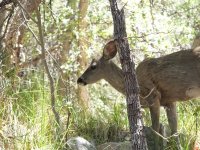-
Welcome to BirdForum, the internet's largest birding community with thousands of members from all over the world. The forums are dedicated to wild birds, birding, binoculars and equipment and all that goes with it.
Please register for an account to take part in the discussions in the forum, post your pictures in the gallery and more.
You are using an out of date browser. It may not display this or other websites correctly.
You should upgrade or use an alternative browser.
You should upgrade or use an alternative browser.
Southeast Arizona, May 2017 (1 Viewer)
- Thread starter Hamhed
- Start date
More options
Who Replied?Hamhed
Well-known member
May 28
Waking to a softly tooting Whiskered Screech-Owl, we broke camp, drove half the distance back to Onion Saddle and were searching for the Slate-throated Redstart by 6:30. In less than 10 minutes, Liz located the bird in thick brush on the uphill slope. Good views were had as it foraged on both sides of the road though it kept moving and would often get out of range. We noticed it was keeping company with a Painted Redstart. Focused on this very rare bird, we were ignoring the nearby Red-faced Warbler, Yellow-eyed Juncos, and others. More than 90 minutes passed before we left but by then, other birders had joined us and all were getting their own lifer looks and probably better pictures.
At Onion Saddle, we turned towards Barfoot and Rustler Parks, gaining a bit more altitude and parked near a fork in the road at 8200 feet (2500M). Following bird sounds, we first walked through a sparse evergreen forest to a knoll about 100 feet higher (30M), seeing good quality high elevation species. First pair of Mexican Chickadees, then the Audubon’s race of a Yellow-rumped Warbler, many Yellow-eyed Juncos, Plumbeous and Warbling Vireos, Northern Flicker’s and several bright Western Tanagers. The elevation was to be our highest and the view was to be the longest. A Red-tailed Hawk rode the strong winds at eye level and Common Ravens called around us. We retraced our steps and walked the level road in the comfortably cool air towards Rustler Park, passing just a few campers. There were Yellow-eyed Juncos, House Wrens, Plumbeous Vireos and Spotted Towhees but also a Hairy Woodpecker, Brown Creepers, Stellar’s Jays and one Pygmy Nuthatch buried in the needles of a slender pine. One particular bird I’d hoped to see eventually called somewhere in the longleaf pine trees and we tracked the sound to a pair of Olive Warblers. This was only our second sighting, the first being brief and ten years ago. Nothing easy about getting any photos of these birds but we spent some time doing our best, ending our three hours of birding with a good list.
After lunch, we made the long and tedious journey down to the Idlewild Campground, picked out an open campsite to spend our next two nights. While walking with birders at the San Pedro House, we were told to seek out Dave Jasper and his new house just outside Portal. Our directions were perfect and his yard was nearly so. We caught Dave just as he was leaving with his mountain bike. He graciously stopped for a short bit of conversation and pointed out an overhead Zone-tailed Hawk before we stepped into his fenced yard. Within an hour we had 26 species, adding, besides the Hawk, Inca Dove, Bullock’s Oriole and Barn Swallow to our trip list. Activity was constant with many types of feeders and seed on the ground.
The day continued with a trip to the Portal store for ice cream, (satisfying my addiction), and a five mile drive to the Southwestern Research Station (http://www.amnh.org/our-research/southwestern-research-station/about/). The hummingbird feeders here are said to be dependable for the uncommon Blue-throated Hummingbird, which turned out to be no rumor. Rivoli’s, Black-chinned and Broad-tailed came for the sugar water as well.
Back at our campsite, at the foot of a boulder strewn slope, food cooked and bins cleaned, we crashed to the sound of a single Elf Owl.
I want to add here a mildly troublesome cell phone oddity. Being in such close proximity to New Mexico, our phones would sometimes be routed to a tower in that state instead of one in Arizona. The problem was in that fact that Arizona, unlike New Mexico, did not observe daylight savings time, and often my phone would be an hour different than Liz’s. We used the car clock whenever confusion resulted.
Waking to a softly tooting Whiskered Screech-Owl, we broke camp, drove half the distance back to Onion Saddle and were searching for the Slate-throated Redstart by 6:30. In less than 10 minutes, Liz located the bird in thick brush on the uphill slope. Good views were had as it foraged on both sides of the road though it kept moving and would often get out of range. We noticed it was keeping company with a Painted Redstart. Focused on this very rare bird, we were ignoring the nearby Red-faced Warbler, Yellow-eyed Juncos, and others. More than 90 minutes passed before we left but by then, other birders had joined us and all were getting their own lifer looks and probably better pictures.
At Onion Saddle, we turned towards Barfoot and Rustler Parks, gaining a bit more altitude and parked near a fork in the road at 8200 feet (2500M). Following bird sounds, we first walked through a sparse evergreen forest to a knoll about 100 feet higher (30M), seeing good quality high elevation species. First pair of Mexican Chickadees, then the Audubon’s race of a Yellow-rumped Warbler, many Yellow-eyed Juncos, Plumbeous and Warbling Vireos, Northern Flicker’s and several bright Western Tanagers. The elevation was to be our highest and the view was to be the longest. A Red-tailed Hawk rode the strong winds at eye level and Common Ravens called around us. We retraced our steps and walked the level road in the comfortably cool air towards Rustler Park, passing just a few campers. There were Yellow-eyed Juncos, House Wrens, Plumbeous Vireos and Spotted Towhees but also a Hairy Woodpecker, Brown Creepers, Stellar’s Jays and one Pygmy Nuthatch buried in the needles of a slender pine. One particular bird I’d hoped to see eventually called somewhere in the longleaf pine trees and we tracked the sound to a pair of Olive Warblers. This was only our second sighting, the first being brief and ten years ago. Nothing easy about getting any photos of these birds but we spent some time doing our best, ending our three hours of birding with a good list.
After lunch, we made the long and tedious journey down to the Idlewild Campground, picked out an open campsite to spend our next two nights. While walking with birders at the San Pedro House, we were told to seek out Dave Jasper and his new house just outside Portal. Our directions were perfect and his yard was nearly so. We caught Dave just as he was leaving with his mountain bike. He graciously stopped for a short bit of conversation and pointed out an overhead Zone-tailed Hawk before we stepped into his fenced yard. Within an hour we had 26 species, adding, besides the Hawk, Inca Dove, Bullock’s Oriole and Barn Swallow to our trip list. Activity was constant with many types of feeders and seed on the ground.
The day continued with a trip to the Portal store for ice cream, (satisfying my addiction), and a five mile drive to the Southwestern Research Station (http://www.amnh.org/our-research/southwestern-research-station/about/). The hummingbird feeders here are said to be dependable for the uncommon Blue-throated Hummingbird, which turned out to be no rumor. Rivoli’s, Black-chinned and Broad-tailed came for the sugar water as well.
Back at our campsite, at the foot of a boulder strewn slope, food cooked and bins cleaned, we crashed to the sound of a single Elf Owl.
I want to add here a mildly troublesome cell phone oddity. Being in such close proximity to New Mexico, our phones would sometimes be routed to a tower in that state instead of one in Arizona. The problem was in that fact that Arizona, unlike New Mexico, did not observe daylight savings time, and often my phone would be an hour different than Liz’s. We used the car clock whenever confusion resulted.
Attachments
Hamhed
Well-known member
May 29
There was one particular species we wanted to while in the area. The desert scrub of yucca and mesquite was favored habitat for Bendire’s Thrasher. Not a showy bird, the Bendire’s looked similar to the more common Curve-billed Thrasher. By eBird reports, the best location was long, straight and dusty Stateline Road where the yuccas were now blooming. We drove 6 miles (9.6K) east out of Portal to the New Mexico border and stopped at the intersection. Camera still in my pack, who knew we would see the bird atop a nearby shrub almost before the car was turned off! At close proximity, the short, almost straight bill was distinctive after seeing a number of the Curve-billed variety. Naturally, by the time we could react, the bird was gone, probably its own reaction to the frenzied commotion in the car. We stayed and searched and drove the road for almost two hours, wanting a picture to document our find but without luck. I did find a singing Scaled Quail for a consolation photo.
After breakfast and some internet access at the Portal store, we wanted to stretch our legs on the South Fork trail which really is the continuation of South Fork Road. Right off, we found a calling Elegant Trogon, our first sighting of the trip. Other birds were fairly common species. We had another Cooper’s Hawk, some Hermit Thrushes and a Grace’s Warbler I chased through the sycamores, trying in vain for a photo. Old friends Plumbeous Vireos, Bushtits, Black-headed Grosbeaks, White-breasted Nuthatches, Acorn Woodpeckers were all there, no one species in abundance.
Somewhere, somehow, I’d misplaced my Tilley hat. To look in the most likely location, we drove to the Southwest Research Station but didn’t find it there. At the time, we had no other idea as to where to look, so we returned to South Fork road, walking and birding. Birds were similar to species on the trail, though our first bird, at the small bridge, was a Black Phoebe. More singing Trogons were found, Painted Redstarts, Canyon Wrens, a Blue-throated Hummingbird, Wood-Pewees, a Scott’s Oriole and more. The road was gravel and, in this dry season, dusty from the occasional passing vehicle but the late morning walk was very pleasant.
In this relaxed frame of mind, I happened to remember having my hat at Dave Jasper’s house. After dropping Liz off at the campsite, I drove the short distance to Dave’s and found my hat under a small rock on the picnic table. On the inside of the Tilley hat is a small pocket that I used to keep a copy of my passport for when we traveled internationally in December of 2016. Recovery of the hat was a great relief.
Rejoining Liz at the campsite, I was fortunate to look up at the same time that a band of pigeons flew over, one lighting atop a dead branch. They would likely be the only Band-tailed Pigeons for our time in Arizona.
After some time at the Portal store, we found ourselves once again at Dave Jasper’s active yard for a short while, talking with Dave. I hadn’t mentioned that we were seeing a few clouds today with a 20% chance of raining the forecast. We experienced what Dave called the “swamp cooler” effect where rain trying to reach the earth in fact evaporates on the way down, cooling the air but never wetting the ground. That afternoon, we were able to feel that cool air sitting at the picnic table in his yard. If the normal 6% humidity went up, we couldn’t tell.
Still bugging us however, was the missed Bendire’s photo so off we went in the late afternoon to Stateline Road, trolling for thrashers. Miles later, at Willow Tank, where the Bendire’s was also possible, we circled the water, finding two White-faced Ibis for the trip list and our second Loggerhead Shrike. American Coots and Mallards were the only other water birds. In migration, this is supposedly quite the hotspot. There were also Red-winged Blackbirds, Blue Grosbeaks, Gambel’s Quail, Barn Swallows and a few other common birds. One Curve-billed Thrasher had us briefly excited. In our mind, the day and the search for the Bendire’s was pretty much over so we hit Stateline Road with purpose, though without completely losing our optimism. It was at the intersection of Gin and Stateline that we slid to a halt, backed up and were both able to snap a few quick pics of a Bendire’s Thrasher perched on a fence post.
We couldn’t hope for a better finish to the day but we tried anyway. Based on a hot tip, we did go out later and check out a hole in a sycamore for a Whiskered Screech-Owl that never appeared.
There was one particular species we wanted to while in the area. The desert scrub of yucca and mesquite was favored habitat for Bendire’s Thrasher. Not a showy bird, the Bendire’s looked similar to the more common Curve-billed Thrasher. By eBird reports, the best location was long, straight and dusty Stateline Road where the yuccas were now blooming. We drove 6 miles (9.6K) east out of Portal to the New Mexico border and stopped at the intersection. Camera still in my pack, who knew we would see the bird atop a nearby shrub almost before the car was turned off! At close proximity, the short, almost straight bill was distinctive after seeing a number of the Curve-billed variety. Naturally, by the time we could react, the bird was gone, probably its own reaction to the frenzied commotion in the car. We stayed and searched and drove the road for almost two hours, wanting a picture to document our find but without luck. I did find a singing Scaled Quail for a consolation photo.
After breakfast and some internet access at the Portal store, we wanted to stretch our legs on the South Fork trail which really is the continuation of South Fork Road. Right off, we found a calling Elegant Trogon, our first sighting of the trip. Other birds were fairly common species. We had another Cooper’s Hawk, some Hermit Thrushes and a Grace’s Warbler I chased through the sycamores, trying in vain for a photo. Old friends Plumbeous Vireos, Bushtits, Black-headed Grosbeaks, White-breasted Nuthatches, Acorn Woodpeckers were all there, no one species in abundance.
Somewhere, somehow, I’d misplaced my Tilley hat. To look in the most likely location, we drove to the Southwest Research Station but didn’t find it there. At the time, we had no other idea as to where to look, so we returned to South Fork road, walking and birding. Birds were similar to species on the trail, though our first bird, at the small bridge, was a Black Phoebe. More singing Trogons were found, Painted Redstarts, Canyon Wrens, a Blue-throated Hummingbird, Wood-Pewees, a Scott’s Oriole and more. The road was gravel and, in this dry season, dusty from the occasional passing vehicle but the late morning walk was very pleasant.
In this relaxed frame of mind, I happened to remember having my hat at Dave Jasper’s house. After dropping Liz off at the campsite, I drove the short distance to Dave’s and found my hat under a small rock on the picnic table. On the inside of the Tilley hat is a small pocket that I used to keep a copy of my passport for when we traveled internationally in December of 2016. Recovery of the hat was a great relief.
Rejoining Liz at the campsite, I was fortunate to look up at the same time that a band of pigeons flew over, one lighting atop a dead branch. They would likely be the only Band-tailed Pigeons for our time in Arizona.
After some time at the Portal store, we found ourselves once again at Dave Jasper’s active yard for a short while, talking with Dave. I hadn’t mentioned that we were seeing a few clouds today with a 20% chance of raining the forecast. We experienced what Dave called the “swamp cooler” effect where rain trying to reach the earth in fact evaporates on the way down, cooling the air but never wetting the ground. That afternoon, we were able to feel that cool air sitting at the picnic table in his yard. If the normal 6% humidity went up, we couldn’t tell.
Still bugging us however, was the missed Bendire’s photo so off we went in the late afternoon to Stateline Road, trolling for thrashers. Miles later, at Willow Tank, where the Bendire’s was also possible, we circled the water, finding two White-faced Ibis for the trip list and our second Loggerhead Shrike. American Coots and Mallards were the only other water birds. In migration, this is supposedly quite the hotspot. There were also Red-winged Blackbirds, Blue Grosbeaks, Gambel’s Quail, Barn Swallows and a few other common birds. One Curve-billed Thrasher had us briefly excited. In our mind, the day and the search for the Bendire’s was pretty much over so we hit Stateline Road with purpose, though without completely losing our optimism. It was at the intersection of Gin and Stateline that we slid to a halt, backed up and were both able to snap a few quick pics of a Bendire’s Thrasher perched on a fence post.
We couldn’t hope for a better finish to the day but we tried anyway. Based on a hot tip, we did go out later and check out a hole in a sycamore for a Whiskered Screech-Owl that never appeared.
Attachments
Hamhed
Well-known member
May 30
Our plan was to leave the area later in the day. An hour and a half on South Fork road in the morning hours produced a nice selection of western species, including Trogons, Black Phoebe, Canyon Wrens, Grace’s warblers, Painted Redstarts, Black-headed Grosbeaks, Spotted Towhees, Mexican Jays (we will miss their nearly constant presence!), Bridled Titmice, Plumbeous Vireos, Woodpeckers and Flycatchers.
On the way to a hiking trail, we passed through Sunny Flats campground, surprised to see another 4 Band-tailed Pigeons flying through.
Our hike was to Crystal Cave, not memorable as far as birds go except for a good look at a Black-throated Gray Warbler foraging in a dry wash. The cave was gated, I think as bat protection, so we got a good leg stretch in, ready for some time on a car seat.
Camping gear packed away, we dropped off unused propane at Dave Jasper’s NEW place, stopped briefly at Dave Jasper’s OLD place, now run by Bob Rodrigues. A number of unusual birds have been seen here. A Streak-backed Oriole was here until early May and a Rose-breasted Grosbeak was currently being seen on occasion. We had no such luck and, ready for the road, headed into New Mexico for Route 80 north. 80 goes to Interstate 10, 10 goes to Wilcox where we would stop for a different kind of birding.
Lake Cochise is a small impoundment surrounded by an unbuilt subdivision, a little awkward to find if one is not familiar with the area. It is possible to drive around the small lake as we did. Naturally, considering the habitat, we added several species to our growing list. According to eBird, several were considered “rare” - Ring-billed Gull, Marbled Godwit, Long-billed Curlew and Northern Shoveler. A good number of American Avocets and two Black-necked Stilts foraged under many Barn Swallows. Numerous White-faced Ibis and a few Killdeer added to the birdlife. Horned Larks were in the grass and along the edges of the gravel road.
This was all different and exciting stuff but more so was a wide storm, approaching from the south and carrying a great deal of lightning. No time to be birding in the open, we drove back out to the westbound interstate for the city of Benson and our motel. The storm was moving apparently fast and caught up with us, pounding rain and winds making conversation in the car difficult, the wiper blades barely keeping up with the torrent. As we forged forward and came out of the worst, we could see ahead yet another hazard, this one a massive wall of dust, stirred up by the ongoing rain storm. By keeping up our speed as much as we dared, we beat that mess to a rest area, parking briefly and admiring our now clean car. Minutes later, we were in the parking lot at a Benson motel. Luck would have it that the large glass doors in our room faced a shrubby piece of desert that provided birding amusement as we sorted and packed some of our gear in late afternoon. No fewer than 11 Gambel’s Quail, parents with fledglings in tow, Say’s Phoebe’s, Barn Swallows, Doves, and Great-tailed Grackles.
A regular mattress was very nice for my aging bones but, sadly, there would be no owls or whip-poor-wills heard.
Our plan was to leave the area later in the day. An hour and a half on South Fork road in the morning hours produced a nice selection of western species, including Trogons, Black Phoebe, Canyon Wrens, Grace’s warblers, Painted Redstarts, Black-headed Grosbeaks, Spotted Towhees, Mexican Jays (we will miss their nearly constant presence!), Bridled Titmice, Plumbeous Vireos, Woodpeckers and Flycatchers.
On the way to a hiking trail, we passed through Sunny Flats campground, surprised to see another 4 Band-tailed Pigeons flying through.
Our hike was to Crystal Cave, not memorable as far as birds go except for a good look at a Black-throated Gray Warbler foraging in a dry wash. The cave was gated, I think as bat protection, so we got a good leg stretch in, ready for some time on a car seat.
Camping gear packed away, we dropped off unused propane at Dave Jasper’s NEW place, stopped briefly at Dave Jasper’s OLD place, now run by Bob Rodrigues. A number of unusual birds have been seen here. A Streak-backed Oriole was here until early May and a Rose-breasted Grosbeak was currently being seen on occasion. We had no such luck and, ready for the road, headed into New Mexico for Route 80 north. 80 goes to Interstate 10, 10 goes to Wilcox where we would stop for a different kind of birding.
Lake Cochise is a small impoundment surrounded by an unbuilt subdivision, a little awkward to find if one is not familiar with the area. It is possible to drive around the small lake as we did. Naturally, considering the habitat, we added several species to our growing list. According to eBird, several were considered “rare” - Ring-billed Gull, Marbled Godwit, Long-billed Curlew and Northern Shoveler. A good number of American Avocets and two Black-necked Stilts foraged under many Barn Swallows. Numerous White-faced Ibis and a few Killdeer added to the birdlife. Horned Larks were in the grass and along the edges of the gravel road.
This was all different and exciting stuff but more so was a wide storm, approaching from the south and carrying a great deal of lightning. No time to be birding in the open, we drove back out to the westbound interstate for the city of Benson and our motel. The storm was moving apparently fast and caught up with us, pounding rain and winds making conversation in the car difficult, the wiper blades barely keeping up with the torrent. As we forged forward and came out of the worst, we could see ahead yet another hazard, this one a massive wall of dust, stirred up by the ongoing rain storm. By keeping up our speed as much as we dared, we beat that mess to a rest area, parking briefly and admiring our now clean car. Minutes later, we were in the parking lot at a Benson motel. Luck would have it that the large glass doors in our room faced a shrubby piece of desert that provided birding amusement as we sorted and packed some of our gear in late afternoon. No fewer than 11 Gambel’s Quail, parents with fledglings in tow, Say’s Phoebe’s, Barn Swallows, Doves, and Great-tailed Grackles.
A regular mattress was very nice for my aging bones but, sadly, there would be no owls or whip-poor-wills heard.
Attachments
Hamhed
Well-known member
May 31
Our final day was spent in the east section of Saguaro National Park. We were here mainly for the hope of finding a Gila Monster, a venomous lizard that can reach 2 feet (.6M) in length and 5 pounds in weight. They are slow moving and like spending time underground, about 90% of the year! There were desert birds here among the saguaros and other strange cactus forms. After an hour’s drive from the motel in Benson to the park entrance, we started out for a short walk on the Cactus Forest trail. Not ready to quit foraging, Lesser Nighthawks winged low over the mesquite. Gila Woodpeckers called from their cactus holes and the sound of Cactus Wrens surrounded us. House Finches were surprisingly very common; one Rufous-crowned Sparrow was seen. The trifecta of gnatcatchers was achieved when we saw a pair of Black-tailed Gnatcatchers.
We then made a longer trek from the Javelina Picnic Area, temperatures definitely climbing with the sun. More desert species, including Ash-throated and Brown-crested Flycatchers, Curve-billed Thrashers, many more Cactus Wrens, Gila Woodpeckers and, our final species for the trip list, two Gilded Flickers. Black-Tailed Gnatcatchers continued being seen, with one on a nest. One quintessential desert species, a Greater Roadrunner, completed our final desert experience.
Lizards? Well, we saw quite a few but no Gila Monster. Our favorite was a Regal Horned Lizard, a walking hand full of thorns.
By noon, the temperatures had reached 90 degrees (32C) so we opted to take a drive to Mount Lemmon and find some cooler, shaded location to spend our final Arizona hours. At 600 feet though, temperatures were still in the 80’s and the trail we ended up on, the Bug Springs trail, was steep, exposed and our time limits with the rental car caught up with us. We managed a few last species, Western Tanager, Black-headed Grosbeak and a soaring Red-tailed Hawk, kept company by a Turkey Vulture.
Enterprise accepted the rain washed car with no complaints. We caught a shuttle to the Comfort Inn, ate supper at the restaurant in the adjacent Double Tree Motel and finalized our packing for a flight scheduled to depart at 7 am.
Our final day was spent in the east section of Saguaro National Park. We were here mainly for the hope of finding a Gila Monster, a venomous lizard that can reach 2 feet (.6M) in length and 5 pounds in weight. They are slow moving and like spending time underground, about 90% of the year! There were desert birds here among the saguaros and other strange cactus forms. After an hour’s drive from the motel in Benson to the park entrance, we started out for a short walk on the Cactus Forest trail. Not ready to quit foraging, Lesser Nighthawks winged low over the mesquite. Gila Woodpeckers called from their cactus holes and the sound of Cactus Wrens surrounded us. House Finches were surprisingly very common; one Rufous-crowned Sparrow was seen. The trifecta of gnatcatchers was achieved when we saw a pair of Black-tailed Gnatcatchers.
We then made a longer trek from the Javelina Picnic Area, temperatures definitely climbing with the sun. More desert species, including Ash-throated and Brown-crested Flycatchers, Curve-billed Thrashers, many more Cactus Wrens, Gila Woodpeckers and, our final species for the trip list, two Gilded Flickers. Black-Tailed Gnatcatchers continued being seen, with one on a nest. One quintessential desert species, a Greater Roadrunner, completed our final desert experience.
Lizards? Well, we saw quite a few but no Gila Monster. Our favorite was a Regal Horned Lizard, a walking hand full of thorns.
By noon, the temperatures had reached 90 degrees (32C) so we opted to take a drive to Mount Lemmon and find some cooler, shaded location to spend our final Arizona hours. At 600 feet though, temperatures were still in the 80’s and the trail we ended up on, the Bug Springs trail, was steep, exposed and our time limits with the rental car caught up with us. We managed a few last species, Western Tanager, Black-headed Grosbeak and a soaring Red-tailed Hawk, kept company by a Turkey Vulture.
Enterprise accepted the rain washed car with no complaints. We caught a shuttle to the Comfort Inn, ate supper at the restaurant in the adjacent Double Tree Motel and finalized our packing for a flight scheduled to depart at 7 am.
Attachments
Hamhed
Well-known member
Though I've put quite a few hours into this report, i could edit it forever, adding or subtracting details and photos. I may add eBird report links some day but migration season is just beginning here in western North Carolina and I'd rather be birding!
Here's hoping to stir up memories for those who have been to this part of the US or help with planning for anyone who might want to go. Of course, I would be glad to go into further detail for anyone who isn't sound asleep by now!
Steve
Here's hoping to stir up memories for those who have been to this part of the US or help with planning for anyone who might want to go. Of course, I would be glad to go into further detail for anyone who isn't sound asleep by now!
Steve
Attachments
Farnboro John
Well-known member
A tremendous report and I'm envious of your success with the birds (and the reptiles, even though you missed Gila Monster).
What about mammals though? You must have seen some. Even approximate IDs would be of interest as I try to assess the idea of going to this area.
Cheers
John
What about mammals though? You must have seen some. Even approximate IDs would be of interest as I try to assess the idea of going to this area.
Cheers
John
foresttwitcher
Virtually unknown member

I enjoyed reading that, thanks for posting.
Hamhed
Well-known member
A tremendous report and I'm envious of your success with the birds (and the reptiles, even though you missed Gila Monster).
What about mammals though? You must have seen some. Even approximate IDs would be of interest as I try to assess the idea of going to this area.
Cheers
John
Thank you, John. We saw a great many lizards and a Desert Kingsnake in additiion to the two mentioned in the report.
Photos of all the undomesticated mammals we saw. The species of deer is unknown. I understand there are Mule Deer, with large ears, (are these "large"?) and White-tailed Deer are the two species in SE Arizona. To go to the subspecies level, they have the Rocky Mountain Mule Deer and the Coues White-tail. It will take someone more knowledgeable than I to make an i.d. out of the only picture we have.
Steve
Attachments
Hamhed
Well-known member
I enjoyed reading that, thanks for posting.
Glad you liked it. I expected it would be a two day read though!
Steve
Users who are viewing this thread
Total: 2 (members: 0, guests: 2)




